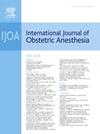Anaesthesia practices for caesarean delivery in three clinical scenarios: the French CLATAC survey (2022–2023)
IF 2.3
3区 医学
Q2 ANESTHESIOLOGY
引用次数: 0
Abstract
Background
Intraoperative pain during caesarean delivery (CD) remains a concern, particularly with epidural anaesthesia, with variable incidence depending on the circumstances. While spinal anaesthesia is the standard for scheduled CD, the best approach for unscheduled CD, especially with inadequate conversion of labour epidural analgesia to surgical epidural anaesthesia, remains unclear. We aimed to describe preferred anaesthetic practices among French anaesthesiologists in different clinical scenarios, with a particular focus on intrapartum CD with failed conversion of labour epidural analgesia.
Methods
A nation-wide, anonymous, online survey was distributed to anaesthesiologists. Participants were asked to indicate their preferred practices in clinical scenarios, including cases without labour epidural analgesia, with adequate labour epidural analgesia, and with inadequate conversion to surgical epidural anaesthesia, for three emergency levels.
Results
Between November 2022 and January 2023, 651 anaesthesiologists responded. Most respondents indicated preferring spinal anaesthesia for scheduled (97 %) and unscheduled non-urgent CD without LEA (95 %). In emergency situations, general anaesthesia (GA) was preferred (84 %). With adequate labour epidural analgesia, 99 % favoured epidural conversion. With inadequate labour epidural analgesia, 43 % indicated preferring spinal anaesthesia in non-urgent situations, while 70 % would opt for GA in emergency cases. Only 63 % of respondents were aware of risk factors for epidural conversion failure.
Conclusions
Anaesthetic practices were heterogeneous, particularly with inadequate labour epidural analgesia. These findings highlight the need for broader dissemination of updated guidelines and for standardized, evidence-based, clinical decision algorithms to support safe and effective anaesthetic management in complex clinical scenarios.
三种临床情况下剖宫产的麻醉实践:法国CLATAC调查(2022-2023)
背景:剖宫产(CD)术中疼痛仍然是一个值得关注的问题,特别是硬膜外麻醉,其发生率取决于具体情况。虽然脊髓麻醉是计划CD的标准,但计划外CD的最佳方法,特别是在分娩硬膜外镇痛不充分转化为手术硬膜外麻醉的情况下,仍不清楚。我们的目的是描述法国麻醉师在不同临床情况下的首选麻醉做法,特别关注分娩时硬膜外镇痛转换失败的分娩CD。方法:在全国范围内对麻醉医师进行匿名在线调查。参与者被要求指出他们在临床情况下的首选做法,包括在三种紧急情况下,无分娩硬膜外镇痛、分娩硬膜外充分镇痛和未充分转为手术硬膜外麻醉的情况。结果:在2022年11月至2023年1月期间,651名麻醉师做出了回应。大多数应答者表示首选脊髓麻醉的计划(97%)和非计划的非紧急CD没有LEA(95%)。在紧急情况下,首选全身麻醉(84%)。充分的分娩硬膜外镇痛,99%赞成硬膜外转换。由于分娩时硬膜外镇痛不足,43%的人表示在非紧急情况下更倾向于脊髓麻醉,而70%的人在紧急情况下会选择GA。只有63%的应答者知道硬膜外转换失败的危险因素。结论:麻醉实践是不同的,特别是分娩时硬膜外镇痛不足。这些发现强调需要更广泛地传播更新的指南和标准化的、循证的临床决策算法,以支持在复杂的临床情况下安全有效的麻醉管理。
本文章由计算机程序翻译,如有差异,请以英文原文为准。
求助全文
约1分钟内获得全文
求助全文
来源期刊
CiteScore
4.70
自引率
7.10%
发文量
285
审稿时长
58 days
期刊介绍:
The International Journal of Obstetric Anesthesia is the only journal publishing original articles devoted exclusively to obstetric anesthesia and bringing together all three of its principal components; anesthesia care for operative delivery and the perioperative period, pain relief in labour and care of the critically ill obstetric patient.
• Original research (both clinical and laboratory), short reports and case reports will be considered.
• The journal also publishes invited review articles and debates on topical and controversial subjects in the area of obstetric anesthesia.
• Articles on related topics such as perinatal physiology and pharmacology and all subjects of importance to obstetric anaesthetists/anesthesiologists are also welcome.
The journal is peer-reviewed by international experts. Scholarship is stressed to include the focus on discovery, application of knowledge across fields, and informing the medical community. Through the peer-review process, we hope to attest to the quality of scholarships and guide the Journal to extend and transform knowledge in this important and expanding area.

 求助内容:
求助内容: 应助结果提醒方式:
应助结果提醒方式:


